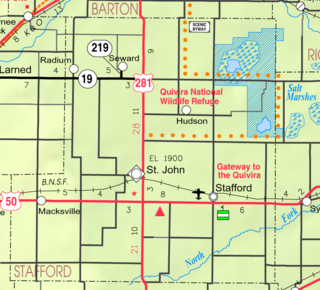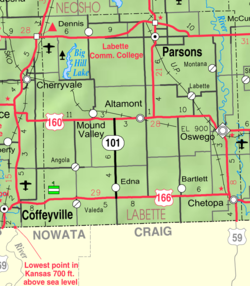
Moran is a city in Allen County, Kansas, United States. As of the 2020 census, the population of the city was 466.

Kincaid is a city in Anderson County, Kansas, United States. As of the 2020 census, the population of the city was 103.

Isabel is a city in Barber County, Kansas, United States. As of the 2020 census, the population of the city was 68.

Kiowa is a city in Barber County, Kansas, United States. As of the 2020 census, the population of the city was 902. It is located 1 mile north of the Kansas / Oklahoma state border.

Hill City is a city and county seat of Graham County, Kansas, United States. As of the 2020 census, the population of the city was 1,403.

Hoyt is a city in Jackson County, Kansas, United States. As of the 2020 census, the population of the city was 593.

Mayetta is a city in Jackson County, Kansas, United States. As of the 2020 census, the population is 348.

Blue Mound is a city in Linn County, Kansas, United States. As of the 2020 census, the population of the city was 219.

Linn Valley is a city in Linn County, Kansas, United States. As of the 2020 census, the population of the city was 956.

Mound City is a city in and the county seat of Linn County, Kansas, United States. As of the 2020 census, the population of the city was 647.

Meade is a city in and the county seat of Meade County, Kansas, United States. As of the 2020 census, the population of the city was 1,505.

Ness City is a city in and the county seat of Ness County, Kansas, United States. As of the 2020 census, the population of the city was 1,329. Ness City is famous for its four-story Old Ness County Bank Building located downtown, and nicknamed Skyscraper of the Plains.

Lyndon is a city in, and the county seat of Osage County, Kansas, United States. As of the 2020 census, the population of the city was 1,037.

Melvern is a city in Osage County, Kansas, United States, along the Marais des Cygnes River. As of the 2020 census, the population of the city was 356.

Quenemo is a city in Osage County, Kansas, United States, along the Marais des Cygnes River. As of the 2020 census, the population of the city was 288.

Long Island is a city in Phillips County, Kansas, United States. As of the 2020 census, the population of the city was 137.

Emmett is a city in Pottawatomie County, Kansas, United States. As of the 2020 census, the population of the city was 170.

Courtland is a city in Republic County, Kansas, United States. As of the 2020 census, the population of the city was 294.

Randolph is a city in Riley County, Kansas, United States. As of the 2020 census, the population of the city was 159.

St. John is a city in and the county seat of Stafford County, Kansas, United States. As of the 2020 census, the population of the city was 1,228.





















